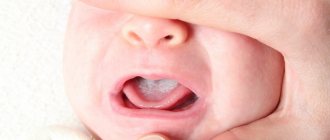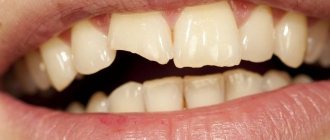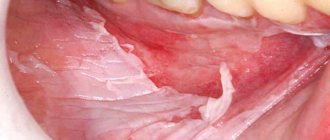Many mothers begin to worry when they see that their child is sucking his tongue. Parents do not know what to do in this situation and whether it is necessary to distract the child from this activity. In fact, such child behavior is not dangerous if it occurs infrequently. If the baby constantly sucks his tongue, then ultimately these actions will lead to unpleasant consequences in the future. In the case of such ambiguous behavior, you should immediately try to figure out what the reason is in order to get rid of this bad habit.
Pacifier to the rescue
At first, parents try to make their baby friends with a pacifier. The pacifier has a calming effect on the baby and satisfies the sucking instinct. Thanks to the rubber thing, the child falls asleep faster, has fun, does not put any unnecessary objects into his mouth, and does not cry after eating. For mothers, a pacifier is an excellent aid in caring for their baby. But many babies completely refuse the delights of this attribute. One child sucks his tongue, another prefers to keep a finger or a piece of sheet in his mouth.
When a baby sucks a finger, pacifier or other thing, parents are not particularly worried, since they can take the foreign object away from the child or stick a finger out of the mouth during sleep. But when a child sucks his tongue, mothers are lost and don’t know what to do: how to wean their child off the habit?
A child over 2 years old sucks his tongue
By this age, the child’s sucking reflex practically fades away, so there is no longer a physiological need for sucking. But a bad habit can remain and even develop at this age. The reasons here are somewhat different.
- The habit of tongue sucking is established in infancy.
- The child experiences anxiety and tries to calm himself down with such “surrogates.” In this case, tongue sucking may be accompanied by other “bad habits”, for example, the child twists his hair, scratches wounds, and bites his nails.
- There can be many reasons for childhood anxiety - strict upbringing in infancy, lack of tactile contact, the child was rarely picked up, they were not helped to sleep when he couldn’t, divorce and quarrels between parents and many other reasons that you will have to look for.
Shutterstock
The 5 most harmful habits of a one-year-old child. How should mom react?
Reasons for tongue sucking
There are several common reasons why a baby uses his own tongue as a pacifier.
- Sucking reflex. Sucking is an important skill in the first months of a baby's life. Thanks to him, the child receives food. In addition, the process itself gives the child great pleasure.
- Calm. Sucking a pacifier, finger, tongue and lip has a calming effect on the baby. Many babies rock themselves to sleep by sucking on a tongue, fingers or corner of a blanket.
- Entertainment. Infants spend the first days and weeks of their lives monotonously. They spend most of their time sleeping or feeding. They don’t know how to play yet, and the growing body requires a variety of actions, so the child sucks his tongue. This way he gets pleasure and entertainment at the same time.
- Brain development. The sucking instinct encourages the child to pull objects and hands into his mouth. The baby learns the world through licking and sucking. At the moment when a child sucks his tongue or finger, the maximum number of muscles in his face is activated, which has a beneficial effect on brain development.
- Lack of care and attention. One of the negative reasons why a child constantly sucks his tongue may be a lack of parental love and attention. If a mother treats her child coldly or has strict views on parenting, this can negatively affect the child’s psychological perception of the world. The child feels lonely and unwanted. He is uncomfortable, lacks hugs and maternal affection. In such cases, he constantly sucks his tongue - this action calms him and replenishes the feeling of uselessness.
- Hunger. In some cases, a child sucks his tongue due to malnutrition. Usually the baby goes hungry in dysfunctional families or in those that adhere to a strict diet.
- No pacifier. Parents must understand: the sucking instinct of babies must be satisfied. Breasts simply need it. If a baby quickly gets enough of breast milk or is bottle-fed, the sucking instinct will not be sufficiently satisfied. In this case, a pacifier will be useful, since its absence provokes tongue or finger sucking.
How to wean an older child from a bad habit
If a child sticks out his tongue or chews it at a time when he is very busy with something, and at other times of the day this does not happen, then there is no need to worry too much. In principle, you don’t even have to scold him or draw attention to it. But if this happens constantly, even in a dream, as a result of an acquired habit from childhood, then in this case the situation requires immediate resolution. First of all, you need to first find out under what circumstances tongue sucking occurs.
Perhaps this happens when the baby is nervous, worried, or, on the contrary, relaxed and about to sleep. Then you need, without focusing on this, try to switch it to any other interesting activity. If you do this constantly and with a positive mood, then over time you can get rid of this bad habit.
Useful tips
If mothers decide to fight the addiction, then before weaning their child from sucking tongue, they need to determine the reasons.
A few simple tips will help parents.
- Spend a lot of time with your baby. Don't be afraid to spoil him. Carry him in your arms, sing lullabies, caress and kiss him, talk to him softly.
- Take care of a calm atmosphere at home. Loud unexpected sounds and screams can cause fear and nervous breakdown in a baby.
- Pay attention to the child’s diet: does he receive sufficient nutrition and fluids? Many mothers tend to believe that when breastfeeding a baby does not need water - this is false, especially if the milk is full-fat. After eating, provide your baby with clean boiled water. Give him food from a spoon or bottle.
- Play with your older baby. Read books to him. Show rattles and clean rubber toys. Entertainment that is accessible to the age group will help you get distracted and not get hung up on bad habits.
- Don't neglect your pacifier. Don't force a pacifier on your baby, but don't shy away from it either. Most people spent the first years of their lives inseparably with a pacifier, but did not spoil their bite and have good teeth. Don't listen to superstitions, do what's best for your baby.
Why does an older baby suck his thumb?
And if the behavior of a newborn baby can be explained by basic instincts, then why does the child suck his thumb in adulthood? Scientists have identified several main reasons for this behavior:
- Fist sucking after 6 months can be explained by the fact that the child’s tongue and oral cavity turns into a means of exploring the world around him and obtaining information important for development. The baby puts everything that gets into his hands into his mouth. This applies to toys, blankets, pet tails and, naturally, your own fingers.
- The obvious reason for baby thumb sucking is hunger. It doesn’t matter whether the baby is breastfed or is fed a special milk formula, sucking is the only way to get food. That is, a baby who puts his fist in his mouth signals to his mother that he is hungry.
- Excessively early weaning often leads to a situation where the child sucks his thumb. Moreover, a certain pattern can be seen - the shorter the period of natural feeding, the higher the likelihood that the baby will begin to put his fist in his mouth.
- Another reason for thumb sucking is teething, which is accompanied by pain. To relieve discomfort and “scratch” irritated gums, the child puts into his mouth not only his fingers and fist, but also any other objects located nearby.
- For the baby, the mother’s breast is a guarantee of security, so he perceives sucking as a way to calm down and feel safe. That is why, in case of any emotional discomfort, alarming situation, or the appearance of a stranger in the house, the child reaches for a finger, as if it were a substitute for the mother’s breast.
- A 2-year-old child (a little younger or a little older) may suck his thumb due to lack of parental attention. When a child is bored without his mother, he subconsciously puts his finger in his mouth to compensate for the warmth of the mother's body.
There is an opinion that children who receive their mother's breast on demand, without any restrictions, very rarely suck their fingers. This is explained simply: babies satisfy all the basic instincts and the desire to be close to their mother.
Call a breastfeeding specialist to your home
At the group's children's medical centers, we know that the most convenient place for breastfeeding consultations is your own cozy home:
- A specialist will come to you at a convenient time. You don't have to go to the clinic and wait in line. Consultations can also be held directly in the maternity hospital (if visits are permissible) or in a medical center.
- A familiar home environment makes consultation easier for both mother and child.
- At home, the consultant will be able to devote more time to both the child and the parents.
- The consultant is always a phone call away: day and night (at night you can call the contact center or write to the consultant, the consultant will answer as soon as possible), on weekdays and on weekends.
- Support from a specialist is not one-time consultations, but accompaniment: the consultant will visit the mother and baby again, if necessary, after 2-4 weeks to check how feeding is going and the baby’s weight gain.
In addition to calling a breastfeeding specialist to your home, you can call doctors of the main specialties: pediatrician, surgeon, allergist, urologist, pulmonologist, hematologist, dermatologist, ophthalmologist, ENT doctor, orthopedist, gastroenterologist and osteopath. You can also take tests, perform physiotherapy and massage at home. Infant swimming consultants can advise you at home and conduct a master class.
Find out about the special offer “Comprehensive examination at home”: the convenience of this program is that you can choose from a list of pediatric doctors exactly those specialists that your child needs and an individual set of medical services with a 20% discount!
As a conclusion
You need to unlearn this bad habit, but if nothing works, then you should stop and take a breath. Thumb sucking is, of course, a worrying sign that requires an adult response. However, it cannot be considered a disaster.
Experts recommend acting consistently and with maximum caution. You cannot force a child; punishment will also not help in the fight against a bad habit.
The choice of the preferred method will depend on several factors, including the age of the child and the cause of the negative addiction. It is better to abandon harsh methods such as smearing mustard on your fingers or tying your hands.
Thus, the process of weaning off the habit of thumb sucking can take a long time. And yet there is no need to despair. The mother needs to gain strength and patience, and the baby will definitely very soon give up the idea of putting his fist in his mouth.
How to correct malocclusion and tongue position.
There must be an integrated approach. Modern orthodontics offers various ways to straighten teeth. But as we have already seen, straightening teeth is ineffective without eliminating the causes leading to these changes.
Therefore, the solution to the problem of malocclusion should be aimed at the entire complex of pathological changes: restoration of the anatomically correct position of the tongue, development of the correct stereotype of swallowing, chewing, head position, posture.
Osteopathic treatment offers exactly this approach: restoration or formation of the correct relationship of anatomical structures
- Correction of weakened or excessively tense muscles of the face, neck, floor of the mouth and the tongue itself, this will lead to the restoration of the correct position of the tongue in the oral cavity and uniform participation of the corresponding muscle chains in the processes of chewing and swallowing.
- The effect on the bone structures that form the cavities of the nose and mouth leads to the restoration of the physiological volumes of these cavities and helps improve nasal breathing, chewing, swallowing and speech.
- Motor innervation of the tongue, swallowing and chewing is provided by the hypoglossal nerve, which exits the cranial cavity through the canal of the hypoglossal nerve, where in some cases it may be compressed. Until a certain age, mobility is maintained in this zone and using osteopathic methods it is possible to restore the physiological correspondence of these anatomical structures.
Signs
During this process, the facial muscles around the mouth tighten on the child's face and the lips compress tightly, forming deep folds. You can observe how the lower lip is retracted between the teeth and comes into contact with the tongue. After waking up, parents often find that the child's lower face and pillow are wet with saliva. When examining the oral cavity of such children, it is clear that they have a smooth tip of the tongue, without roughness or pronounced papillae, with minor hemorrhages. Systematic placement of the tongue in the wrong position causes tooth displacement and the development of an open bite.
What to do, if…
...it doesn’t work
By reducing the number of daytime applications, nightly applications may become longer and more frequent for some time. If the situation does not change after a couple of weeks, this most likely means that the child is still finding it difficult to come to terms with such restrictions. In such a situation with weaning, it may be better to wait.
When your baby starts sucking his finger, lower lip, or anything else, these symptoms cannot be ignored. Your baby is not ready to stop breastfeeding yet. Moreover, this behavior of the baby indicates that it is very difficult for him to come to terms with the changes that are taking place; he suffers greatly internally. And if you do not treat such a quiet protest of the little man with understanding, this can seriously affect the baby’s nervous system in the future.
Category: Master classes.
ABOUT THE PROJECT
As part of the project “Educational photo and video master classes on breastfeeding,” 17 instructions have been created to correct the most common difficulties during breastfeeding. Master classes will be released in photo and video format in Russian and Kazakh languages.
The materials were created for parents and professionals and are available free of charge. All master classes are protected by copyright law. The authors of the project give permission to those who wish to use materials on their resources, provided they maintain a link to the author’s website (original source) - milky-help.org.
If you wish to use these materials to create any printed materials, you must contact the authors of the project to obtain approval. Request permission
The implementation of this project was made possible thanks to the full support of the following organizations:
Publishing house "Resource" Representative office of Biolane children's cosmetics in Kazakhstan Pharmaceutical trading company Pharmacy Plus
We thank the project sponsors for their trust and support in us at all stages of implementation. The models for the master class “Help from a specialist: lying down breastfeeding” were:
- Voloshinenko Liana – breastfeeding consultant, perinatal psychologist, AKEV teacher, teacher and author of the course “Psychology of Motherhood. Natural feeding", coordinator of the branch of the MOO "Molochnaya Pomoshch" in St. Petersburg, head of the MOO "Molochnaya Pomoshch".
- Baby Asadchiy Efim (age – 40 days).
- Elena Asadchaya - breastfeeding consultant, educational psychologist, breastfeeding teacher, coordinator of the branch of the MOO "Dairy Pomoga" in Almaty, head of the MOO "Molochnaya Pomoshch".
The “tongue smoothing” technique may be useful if:
- the child has piston sucking, he does not lay his tongue on the lower gum;
- the child cannot attach to the breast after using a pacifier or breast pad;
— it is necessary to teach the child to suck after cutting the frenulum under the tongue.
You can also let your child suck his finger if you need to diagnose what kind of tongue movements the child is making. And also when a very small child wants to suck, but the mother for some reason cannot breastfeed (for example, she has been weaned), instead of a pacifier, it is more advisable to offer a cleanly washed finger of an adult for sucking (nails should be cut short).
Thumb sucking is used as one of the ways to supplement a baby's feeding without a bottle.
Diagnostics of sucking
The lactation consultant performs the technique while wearing gloves; the mother can limit herself to thorough hand washing. Nails should be cut short to avoid injuring the child.
- It is most convenient to perform the technique with your thumb (the child gets used to the feeling of greater fullness in the mouth, it is more similar to sucking at the breast).
- Position the child comfortably, the head should be slightly thrown back, the back should be straight, nothing should interfere with the free opening of the mouth.
- Bring your bent thumb to your baby's mouth.
- Place the knuckle of the thumb on the baby's lower lip, encouraging him to open his mouth. You can gently press on the sponge so that the child opens his mouth wide.
- When the child has opened his mouth wide enough, straighten your finger - it will fit into the child’s mouth.
- The finger should be deep enough in the mouth (a whole phalanx or a little more). The child should not choke on his finger. The pad of the finger barely touches the palate, the nail lies on the tongue.
- Let your child suck on your finger. If he doesn't start to suck, you can gently stimulate the roof of your mouth with your fingertip.
Correct sucking
When diagnosed, you will feel proper sucking like this:
- You feel the baby's tongue wrap around your finger;
- the tongue is extended so that it covers the lower gum; during sucking movements, the tongue continues to lie on the gum;
- You feel expressing wave-like movements with your tongue;
- The tongue does not slide along the finger “back and forth”.
Incorrect sucking
Improper sucking is most often associated with:
- using breast substitutes (bottle with pacifier, pacifier, breast pads);
- short frenulum under the tongue;
- improper attachment to the breast (how to correct attachment to the breast, you can see here).
Incorrect sucking can be piston-like or shallow peristaltic.
Signs of piston sucking:
- on the tongue, approximately in the center, there is a tubercle with which the child can press his finger against the palate, sometimes quite firmly;
- movements of the tongue along the finger “back and forth”, the amplitude is quite large (more than 5 millimeters);
- the lower gum is not covered with the tongue, the child can strongly squeeze the finger between the gums;
- The baby holds the vacuum while sucking by tensing his lips.
Signs of peristaltic sucking:
- the child’s tongue clasps the finger, the movements are generally correct (see CORRECT SUCKING), but the tongue does not cover the lower gum or periodically slides off it when making sucking movements;
- The child may squeeze the finger tightly with his gums while sucking.
After cutting the frenulum under the tongue, sometimes it is enough to simply attach the baby to the breast correctly. In some situations (for example, a child is accustomed to an incorrect sucking technique, or after surgery the tongue movements are discoordinated), this technique will help to cope.
Correction of improper sucking (tongue smoothing technique)
- After the child has sucked on the finger, slowly and carefully lower the tip of the finger lower (extending the finger) - gradually press the fingernail onto the tubercle of the tongue. Thereby forcing the child to straighten his tongue. You will be able to feel your tongue straighten and move forward.
- After this (almost simultaneously with step 1), slowly pull your finger out of the child’s mouth. He will push his tongue out even more because he doesn’t want to let go of the sucking object.
- This exercise can be repeated several times. After 2-3 repetitions, you can see that when giving a finger, the child will open his mouth wider and lay his tongue on the gum in the shape of a funnel.
- If you feel that the movements of your tongue have changed while sucking your finger, you can give breastfeeding.
- The breast does not help the baby as much as the finger, so the baby may not be able to start sucking correctly right away. Don’t worry, you just need to try your finger a few more times, then your chest again.
- Sometimes retraining can take 1-2 days. At this time, it is advisable that the child does not receive breast substitutes; the mother constantly monitors the correct attachment to the breast. It is advisable to give food without using a bottle with a pacifier. More information about methods of supplementary feeding without a bottle can be found in the master class “Supplementary feeding without a bottle.”
Correction of abnormal sucking in tongue dystonia
For various reasons (neurological disorders, deep cutting of the frenulum under the tongue, etc.), a child may experience tongue dystonia - incorrect distribution of tongue muscle tone. The most common condition is hypertonicity of the superior longitudinal muscle of the tongue. You can deal with this in the following way.
- The tongue smoothing technique is also performed, but with a little emphasis. Lower the tip of your thumb even lower. Slowly pulling your finger out of the child's mouth, use the tip of your finger to press quite intensely on the center of the tongue and move from the base to the tip. The result is a massage effect that allows you to relax your spasmed tongue.
- Repeat the exercise several times. Feeling that the tongue has become more relaxed while sucking a finger, has begun to wrap around the finger like a funnel and extends to the lower gum, you can offer the breast to the baby.
Authors of the master class:
- Voloshinenko Liana – breastfeeding consultant, perinatal psychologist, AKEV teacher, teacher and author of the course “Psychology of Motherhood. Natural feeding”, head of the local public organization “Dairy Help”.
- Asadchaya Elena - breastfeeding consultant, educational psychologist, AKEV teacher, coordinator of the branch of the MOO "Dairy Pomoga" in Almaty, head of the MOO "Molochnaya Pomoshch".
Photo: Marina Tsaplina – family photographer.
GRATITUDE
The implementation of the project to create master classes for mothers and specialists was also made possible thanks to the contribution made by:
Proud Mom - clothes for expectant and nursing mothers. Breastfeeding clothing in the project is provided by the Proud Mom brand
Creative workshop Slingomama.kz
The project was also greatly assisted by the manufacturer of clothing for nursing mothers TM “Bambinomania” and the store for mothers “Ukhti-Tukhti”
Share
Comments
Advantages of calling Virilis Group specialists to your home
- Travel to any area of the city and region without restrictions.
- No insurance, registration or citizenship is required to receive medical care.
- Providing assistance to children of any age.
- Experience in responsible treatment of children in St. Petersburg since 1991.
- 6 own children's medical centers with 650 specialists in 49 specialties.
- Possibility of diagnostics and continuation of treatment in our clinics.
- Coordination with other doctors of the VIRILIS Group of Companies clinics: we are a single team, and not individual doctors from a “mobile” clinic.
- 24/7 contact center.
- Issuance of official medical certificates and documents.
- Possibility of purchasing a package of a comprehensive medical program for a child, including the “Emergency Care” and “Comprehensive Examination at Home” packages.
- Special medical programs for newborns and infants.
Too early
Breastfeeding is a very short stage in a child’s life.
It would be ideal to feed the baby until the age when his need for latching subsides on its own. The age at which a child himself, without mother’s help and serious efforts on her part, is ready to give up breastfeeding usually occurs after three years. The mother’s body is ready to complete lactation earlier - already at 1.5-2 years of age. Completion of lactation at an earlier stage is not physiological and, as a rule, is associated with errors and diseases:
- rare feedings,
- adding water,
- early complementary feeding,
- cracked nipples,
- lactostases,
- mastitis and, as a consequence, lack of milk and underweight of the child,
- or problems with the mother's health.
Weaning before 1 -1.5 years is possible, both planned and emergency, and for this, as a rule, there are good reasons: hospitalization of the mother, the need to take medications incompatible with feeding the child, family situations requiring the mother’s departure, and others unseen circumstances.










